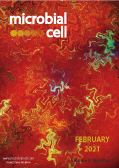Table of contents
Volume 8, Issue 2, pp. 28 - 64, February 2021
Cover: The image was obtained by confocal microscopy (using a Leica SP5). It consists of Bacillus subtilis transformed (separately) with fluorescent proteins TagRFP-T, sfGFP, TagBFP, mKate2 and mOrange2, mixed and plated on solid media for 24h. Images were obtained directly from petri dishes by positioning a cover slip over the growing cells (image by Fernan Federici, Pontificia Universidad Catolica de Chile (Chile) and iBio Institute; Tim Rudge, PJ Steiner and Jim Haseloff, University of Cambridge (UK); image retrieved via wellcomecollection.org); image modified by MIC. The cover is published under the Creative Commons Attribution (CC BY) license.
Enlarge issue cover
Biofilms by bacterial human pathogens: Clinical relevance – development, composition and regulation – therapeutical strategies
Adina Schulze, Fabian Mitterer, Joao P. Pombo and Stefan Schild
Reviews |
page 28-56 | 10.15698/mic2021.02.741 | Full text | PDF |
Abstract
Notably, bacterial biofilm formation is increasingly recognized as a passive virulence factor facilitating many infectious disease processes. In this review we will focus on bacterial biofilms formed by human pathogens and highlight their relevance for diverse diseases. Along biofilm composition and regulation emphasis is laid on the intensively studied biofilms of Vibrio cholerae, Pseudomonas aeruginosa and Staphylococcus spp., which are commonly used as biofilm model organisms and therefore contribute to our general understanding of bacterial biofilm (patho-)physiology. Finally, therapeutical intervention strategies targeting biofilms will be discussed.
A novel BR-SMAD is required for larval development in barber’s pole worm Haemonchus contortus
Fangfang Li, Peixi Qin, Lisha Ye, Nishith Gupta and Min Hu
Research Reports |
page 57-64 | 10.15698/mic2021.02.742 | Full text | PDF |
Abstract
SMAD proteins mediate TGF-β signaling and thereby regulate the metazoan development; however, they are poorly defined in Haemonchus contortus–a common blood-sucking parasitic nematode of small ruminants. Here, we characterized an R-SMAD family protein in H. contortus termed HcSMA2, which is closely related to Caenorhabditis elegans SMA2 (CeSMA2) involved in the bone morphogenetic protein (BMP) signaling. Hcsma2 is transcribed in all developmental stages of H. contortus but highly induced in the adult male worms. The RNA interference with Hcsma2 retarded the transition of infective L3 into L4 larvae. Besides, the bimolecular fluorescence complementation revealed the interaction of HcSMA2 with a TGF-β-activated-R-SMAD (HcDAF8). Together these results show a BMP-like receptor-regulated SMAD in H. contortus that is required for larval differentiation and underscore an adaptive functional repurposing of BMP-signaling in parasitic worms.










